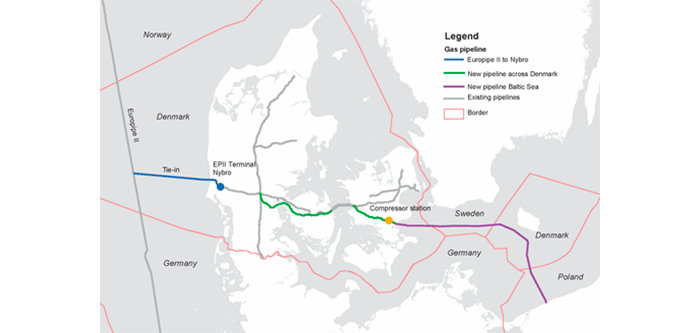The Danish-Polish pipeline project has been granted permits to construct a natural gas pipeline offshore Denmark.
The Minister for Climate, Energy and Supply has today granted permits to Energinet for a section of the Baltic Pipe natural gas pipeline on the maritime and continental shelf in the North Sea and the Little Belt and a permit for Gaz-System S.A on the maritime and continental shelf in the Baltic Sea. On July 12, 2019, the Environmental Protection Agency granted permit to the part of the project onshore.
Baltic Pipe is expected to contribute to Poland’s transition from coal to natural gas, which will reduce the greenhouse gas emissions. In addition, Baltic Pipe is considered to increase the security of gas supply in Denmark because a direct access for the Danish gas system to the Norwegian upstream pipeline, Europipe II is established.
The pipeline project
The pipeline in Danish waters is part of a larger project that will transport
gas from Norway to Poland. The pipeline project runs from Europipe II in the Danish part of the North Sea, across Denmark, among others through Little Belt, through the Danish, Swedish and Polish parts of the Baltic Sea, to Niechorze or Rogowo in Poland. (figure 1).
The full capacity of the Baltic Pipe pipeline is 10 billion m3 of natural gas per year. The total length of the pipeline route is projected to approx. 850 km, of which approx. 105 km of the route is in Danish waters in the North Sea and 4 km in Danish waters in the Little Belt and 133 km in the Baltic Sea. According to the schedule of the companies, construction activities is expected to start in the beginning of 2020 and completed by 2022.
The Danish part of the pipeline project
In the construction permits there are several conditions to ensure that the construction and operation of the offshore pipeline project is done in an environmently and safe sound way, including conditions for minimizing impact on humans, porpoises, Arctic Tern and eelgrass.
The companies have carried out a number of investigations in the North Sea, the Little Belt and the Baltic Sea. Several route alternatives have been investigated in the Danish sea area, including a route through a Natura 2000 area in the Little Belt and a route solely offshore. A route through a Natura 2000 area can only be selected if there is no reasonable alternative outside the Natura 2000 area unless other considerations are so important that a route through a Natura 2000 area is the only option. The route which is covered by the permit for the North Sea and Little Belt does not go through Natura 2000 areas and is therefore considered to be a reasonable alternative. A route solely offshore was investigated by the companies in the initial stages, but was not selected because the route neither was economically nor technically feasible and could have significant consequences for marine nature, especially in shallow marine areas.
The Danish Energy Agency finds that the offshore pipeline project can be constructed and operated without unacceptable impact on the environment and safety if the framework for the project's construction and operation as described in the submitted application and environmental impact report, including the mitigation measures described in the environmental impact report, are implemented and the conditions I the permits are complied with.
Read more about the permits and see the background materials.
Contact:
Head of Mediarelations Ture Falbe-Hansen, mobile: +45 25 13 78 46, e-mail: tfh@ens.dk
Head of Division Carl-Christian Munk-Nielsen, tel: +45 33 92 79 02, e-mail: ccmn@ens.dk
Chief Advisor Katja Scharmann, tel: +45 33 92 66 72, e-mail: ksc@ens.dk
